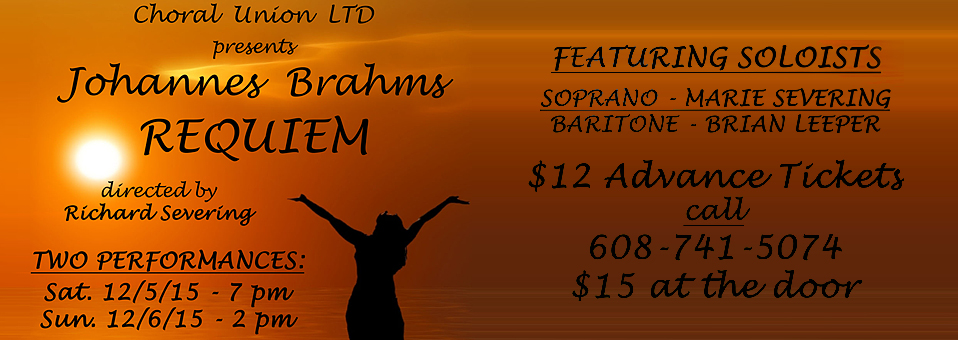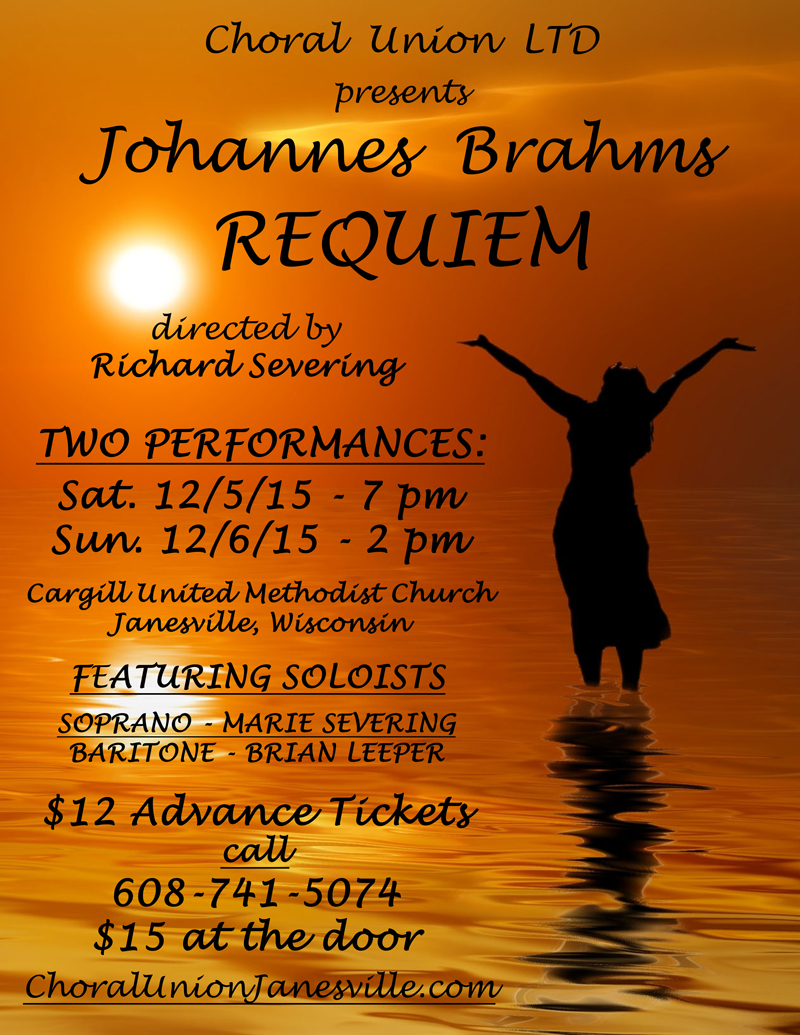Choral Union LTD Presents Johannes Brahms REQUIEM
Choral Union LTD Presents Johannes Brahms REQUIEM Directed by Richard Severing.
TWO PERFORMANCES
Sat 12/05/15 – 7:00pm
Sun 12/06/15 – 2:00pm
FEATURING SOLOISTS
Soprano – Marie Severing
Baritone – Brian Leeper
Tickets:
$12 in Advanced. To purchase call 608-741-5074
or click here for more information.
 MORE ABOUT JOHANNES BRAHMS
MORE ABOUT JOHANNES BRAHMS
Johannes Brahms was born in Hamburg, Germany in May of 1833. His father was a town musician who gave Johannes his first music lessons. He began his piano lessons at the age of seven and as an adolescent, played piano in local dance halls to contribute to the family income. He began conducting choirs in his early teens and performed in a few concerts in Hamburg. Brahms was a perfectionist when it came to his compositions – he destroyed many of his youthful works, and composed very slowly, sometimes taking years to complete a work.
A German Requiem, Brahms’ largest choral work, was first performed in Bremen, Germany in 1868. It was his first major choral and orchestral work, establishing his reputation in Europe as a successor to Beethoven, even though he had not yet written the first of his symphonies. The Requiem was inspired both by the deaths of his friend and benefactor, Robert Schumann, in 1856 and his mother in 1865.
 Brahms did not write A German Requiem as a “normal” requiem. It does not follow the traditional Latin Requiem mass, it is not in Latin, and, perhaps most importantly, it doesn’t follow the typical approach to a Requiem. There are no sections that call for a large group of brass and timpani dramatically (and loudly) describing the “day of wrath”. It is instead, an oratorio, a collection of passages from the bible, emphasizing not just the grief felt at the death of a loved one, but also the hope and blessing for the departed one.
Brahms did not write A German Requiem as a “normal” requiem. It does not follow the traditional Latin Requiem mass, it is not in Latin, and, perhaps most importantly, it doesn’t follow the typical approach to a Requiem. There are no sections that call for a large group of brass and timpani dramatically (and loudly) describing the “day of wrath”. It is instead, an oratorio, a collection of passages from the bible, emphasizing not just the grief felt at the death of a loved one, but also the hope and blessing for the departed one.
“Blessed are they that mourn, for they shall have comfort”.
Brahms uses various passages from the Old and New Testament of the German Bible to build on the idea that “Blessed are they that mourn, for they shall have comfort”. He chose passages that remind us that those who sow with tears and weeping will then reap with joyful singing and come with rejoicing. There is a reminder that life is transitory, that we are like grass and flowers that wither and fall. We must be patient like the farmer who waits for the fruit of the earth, that in the end, there will be everlasting joy for all. The work cycles from this blessing of those mourning to creating a vision of the heavenly host singing of joy and praise, to words of consolation, as from a mother comforting a child, and in the end, returning to a reminder of blessing. The work ends quietly, as it began, ending with the repeated words, “blessed, blessed”.
Brahms wrote two versions of his Variations on a Theme by Joseph Haydn in 1873. The first version was written for two pianos and the second, the better known version, for orchestra. A theme and variations presents a challenge to a composer: select a theme and then write a series of variations based on the theme in different and interesting ways. Brahms chose a chorale called Saint Anthony, supposedly written by Haydn. After presenting the theme, he followed it with eight variations, each with a distinctive character, all demonstrating Brahms’ mastery of different compositional styles. The success of this work gave Brahms the confidence to complete his first symphony in 1876.








Leave a Reply
Want to join the discussion?Feel free to contribute!